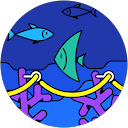Shark Bites Piercing in Nairobi, Kenya
A Shark Bites piercing is a style of lip piercing that consists of four individual piercings, two on each side of the lower lip, positioned close together. This results in a symmetrical look, resembling a shark’s bite, hence the name. This type of piercing can be quite bold and is typically worn with studs, hoops, or captive bead rings. Because it involves multiple piercings, it requires a longer healing period and diligent aftercare to prevent infections or complications.
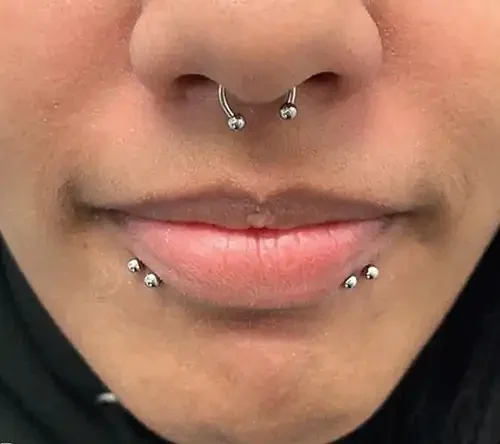
Shark Bites Piercing
Shark Bites Piercing Procedure
The Shark Bites piercing procedure involves creating four separate piercings on the lower lip, with two on each side. Here’s a step-by-step outline of the process:
- Consultation: Our piercer will discuss your desired placement, jewelry options, and provide aftercare instructions. This is a good time to ask any questions or voice concerns.
- Preparation: Our piercer will clean and disinfect the area around your lower lip to prevent infection. They’ll then mark the exact spots where the piercings will be placed, ensuring symmetry.
- Piercing: Using a sterilized hollow needle, our piercer will create each hole one by one. Typically, they start on one side and then move to the other. You’ll feel a sharp pinch for each piercing.
- Jewelry Insertion: After each piercing is made, our piercer will immediately insert the chosen jewelry, usually studs or small hoops. This ensures the holes stay open and begin healing properly.
- Final Cleaning: Our piercer will clean the area again and check to ensure everything looks symmetrical and correctly positioned.
Aftercare: Healing time for Shark Bites piercings can take 2 to 3 months. It’s crucial to keep the area clean, avoid touching or playing with the jewelry, and follow the piercer’s aftercare instructions to prevent infections or complications.
Considerations before getting a Shark Bites Piercing
Before getting a Shark Bites piercing, consider the following factors:
- Pain Level: Since it involves four piercings, expect more discomfort compared to a single piercing. Pain tolerance varies, but be prepared for some sharp pain during the procedure and tenderness afterward.
- Healing Time: This piercing has a longer healing time, typically 2 to 3 months, but it can take up to 6 months to fully heal. You’ll need to be diligent with aftercare, as the healing process requires consistent cleaning.
- Aftercare: You’ll need to clean the piercings 2-3 times daily using a saline solution. Avoid smoking, alcohol, and spicy foods, as these can irritate the piercings.
- Swelling and Irritation: Swelling is common, especially during the first week. Cold compresses or ice chips can help reduce it, but you may also need to avoid activities that could irritate the piercings, such as eating hard or chewy foods.
- Jewelry Options: Initially, you’ll need to wear longer jewelry to accommodate swelling. Once the healing process is complete, you can switch to shorter jewelry or different styles, but this should only be done by a professional.
- Cost: A Shark Bites piercing can be more expensive than single or double piercings due to the number of holes. Make sure you budget for both the procedure and quality jewelry.
- Potential Risks: With any piercing, there’s a risk of infection, rejection, scarring, or migration. Proper aftercare minimizes these risks, but it’s important to monitor for any signs of complications.
- Lifestyle Impact: Consider how this piercing might affect daily activities such as eating, speaking, or playing musical instruments. It can also impact employment in settings with strict appearance policies.
- Piercing Professional: Choose an experienced and reputable piercer who uses sterilized equipment and follows proper hygiene practices to reduce the risk of complications.
- Dental Health: Lip piercings can sometimes cause gum recession, tooth erosion, or enamel damage over time, especially if the jewelry rubs against your gums or teeth. Opt for biocompatible materials like titanium or gold to reduce this risk.
Shark Bites Piercing Pain and Healing
Pain Level
- During the Procedure: Shark Bites piercings can be more painful than a single lip piercing because you’re getting four piercings at once. You’ll feel a sharp pinch for each one, but an experienced piercer will work quickly to minimize discomfort.
- After the Procedure: Expect swelling, tenderness, and throbbing around the pierced areas for a few days. The pain is usually manageable and should gradually subside, but since there are four piercings, it may take a bit longer to feel comfortable compared to less complex piercings.
Healing Time
Typical Healing Duration: The healing period for Shark Bites piercings is around 2 to 3 months, but it can take up to 6 months for complete healing. Healing varies depending on your body’s response, lifestyle, and how well you follow aftercare instructions.
Healing Tips
- Clean Daily: Clean your piercings 2-3 times daily using a saline solution or a piercing aftercare spray. Avoid using alcohol or hydrogen peroxide, as these can dry out and irritate the piercings.
- Avoid Touching: Keep your hands off the piercings unless you’re cleaning them, as touching can introduce bacteria and cause infections.
- Be Careful with Eating: Eat soft foods initially and avoid spicy, acidic, or salty foods that can irritate the piercings.
- Stay Hydrated: Drink plenty of water to help reduce swelling and support healing.
- Avoid Oral Irritants: Refrain from smoking, drinking alcohol, or using harsh mouthwashes during the healing period, as these can slow down the healing process or cause complications.
- Monitor for Issues: Keep an eye out for signs of infection, such as excessive redness, swelling, pain, or pus. If you notice any of these symptoms, consult your piercer or a healthcare professional.
Possible Healing Complications
- Infection: Bacteria can easily enter the piercings, especially during the initial healing period, so be diligent about cleaning.
- Swelling: Swelling is normal in the first week, but if it worsens or doesn’t subside, it could be a sign of an issue.
- Migration or Rejection: If your body doesn’t accept the piercing, it may start to push the jewelry out. This can happen due to improper placement, poor aftercare, or the body’s natural reaction.
By following proper aftercare and being patient, you can help ensure a smoother healing process for your Shark Bites piercings.
Shark Bites Piercing Aftercare
Proper aftercare is crucial for ensuring that your Shark Bites piercings heal well and avoid complications. Here’s a comprehensive guide:
Cleaning Routine
- Saline Solution: Clean your piercings 2-3 times daily using a saline solution or a piercing aftercare spray. You can buy pre-made saline or make your own by mixing 1/4 teaspoon of non-iodized sea salt with 8 ounces of warm distilled water.
- Cleaning Process:
– Wash your hands thoroughly before touching the piercings.
– Soak a clean cotton pad or gauze in the saline solution and gently press it against the piercings for a few minutes.
– Gently remove any crust or debris around the jewelry using the soaked pad. Do not twist or turn the jewelry, as this can cause irritation.
Oral Hygiene
– Rinse After Eating: Rinse your mouth with an alcohol-free, antibacterial mouthwash or saline solution after eating to remove food particles and prevent bacteria build-up.
– Brush Gently: Brush your teeth gently with a soft-bristled toothbrush to avoid irritating the piercings.
Swelling Management
– Cold Compress: Apply a clean, cold compress or ice pack wrapped in a cloth to the outside of your lip to help reduce swelling, especially during the first few days.
– Stay Hydrated: Drinking plenty of water can help reduce swelling and support healing.
Avoid Irritants
– No Touching or Twisting: Avoid touching or twisting the jewelry unnecessarily, as this can introduce bacteria or cause irritation.
– Avoid Smoking and Alcohol: Both can irritate the piercings and slow down the healing process, so it’s best to avoid them during the healing period.
– Stay Away from Spicy, Salty, or Acidic Foods: These can cause discomfort or irritation, so it’s wise to avoid them until your piercings have healed.
Sleep and Lifestyle Tips
– Sleep on Your Back: Try to sleep on your back or on the opposite side of your piercings to avoid pressure on the area.
– Avoid Oral Contact: Refrain from kissing or oral activities that can introduce bacteria to the piercings until they are fully healed.
Monitor for Complications
– Watch for signs of infection such as redness, swelling, pain, heat, or pus. If you suspect an infection, consult your piercer or a healthcare professional promptly.
– Avoid changing the jewelry before the piercings are fully healed (at least 2-3 months) unless instructed by a professional.
Long-Term Care Even after your piercings have healed, continue to maintain good oral hygiene and keep an eye on them to prevent issues like migration or gum recession.
Following these aftercare steps, you can help ensure a smooth healing process for your Shark Bites piercings and reduce the risk of complications.
Shark Bites Piercing Jewelry
Choosing the right jewelry for your Shark Bites piercings is essential for comfort, healing, and style. Here’s a guide to the best options:
Initial Jewelry
- Labret Studs: These are a popular choice for initial jewelry because they have a flat back, reducing irritation against the gums and teeth. They’re available in various lengths to accommodate swelling.
- Captive Bead Rings (CBRs): Some people opt for captive bead rings, which are circular hoops with a small bead that holds the jewelry in place. They allow more room for swelling but can move around more, potentially causing irritation during healing.
- Flat Back Studs: These studs have a flat disc on the back, which helps reduce the risk of the jewelry pressing against the inside of your mouth, making them a comfortable option during the healing process.
Material Options
- Titanium: Hypoallergenic, lightweight, and corrosion-resistant, titanium is one of the safest options for initial piercings, especially if you have sensitive skin or allergies.
- Surgical Stainless Steel: A common choice for body jewelry, surgical stainless steel is durable and affordable. However, it may cause irritation for those with metal sensitivities.
- 14k or 18k Gold: Opt for high-quality gold jewelry (14k or 18k) that is nickel-free to reduce the risk of allergic reactions. Avoid gold-plated jewelry, as the plating can wear off and cause irritation.
- Niobium: Similar to titanium in terms of being hypoallergenic, niobium is a safe and comfortable choice for initial piercings.
Long-Term Jewelry Options
- Labret Studs: Once your piercings are fully healed, you can switch to shorter labret studs for a more snug and subtle look. You can choose from various bead designs or gemstones for a bit of personalization.
- Hoops: If you prefer hoops, you can choose from seamless rings, captive bead rings, or clicker rings. These offer a bolder look and are great for those who want more movement and flexibility with their jewelry.
- Circular Barbells: These are horseshoe-shaped hoops with beads at each end, offering a unique look that’s different from standard rings or studs.
Jewelry Sizes
- Gauge: Shark Bites piercings are typically done with 16-gauge (1.2 mm) or 14-gauge (1.6 mm) needles. Make sure any jewelry you choose matches this gauge to avoid issues with sizing.
- Length/ Diameter: The length or diameter of the jewelry will depend on your anatomy and preferences. Your piercer will usually start with longer or larger jewelry to accommodate swelling, and once healed, you can switch to smaller sizes.
Jewelry Styles for Customization
- Colored Anodized Jewelry: Titanium and niobium can be anodized to create various colors, allowing for a more personalized look.
- Gemstone or Crystal Ends: Opt for labret studs with gemstone or crystal ends for a touch of sparkle.
- Different Shapes: Once healed, you can explore different bead shapes, such as stars, hearts, or skulls, for a more unique style.
Tips for Choosing Jewelry
- Always consult our piercer before changing jewelry, especially during the healing period.
- Avoid cheap, low-quality materials like nickel or plated metals, as they can cause irritation or allergic reactions.
- Make sure the jewelry you choose is smooth and free of any sharp edges that could cause damage or irritation to the piercing.
By choosing high-quality materials and appropriate styles, you’ll ensure your Shark Bites piercings are comfortable, safe, and stylish throughout the healing process and beyond.
Cost of a Shark Bites Piercing in Nairobi, Kenya
The cost of a Shark Bites piercing can vary based on factors such as location, the experience of the piercer, and the quality of the jewelry used. Here’s a breakdown of what to expect:
Average Cost Range
- Overall Cost: The average cost for a Shark Bites piercing ranges from Ksh. 5,000 to Ksh. 10,000. This price includes all four piercings since they are done simultaneously.
- Piercing Per Hole: At Rebel Inks Tattoos, Tattoo Removal and Body Piercings Parlour we may charge per piercing, typically around Ksh. 1,500 to Ksh. 2,500 each, making the total approximately Ksh. 5,000 to Ksh. 10,000
Shark Bites Piercings Cost Breakdown Table
Component / Service | Estimated Cost (KSh) | What’s Included / Notes |
Piercing fee per hole (basic jewelry) | 1,500 – 2,500 | Surgical steel or basic titanium stud; studio labour + time |
All four holes (basic package) | 5,000 – 10,000 | Procedure + basic jewelry for all four |
Premium jewelry upgrade | 500 – 2,000 per piece | For higher-quality material, decorative ends, etc. |
Aftercare kit / supplies | 300 – 1,000 | Saline wash, cleaning solution, ointment or balm, instructions |
Follow-up / jewelry change (after swelling) | 200 – 500 | If the bars need changing, or if you want a different style once healed |
Total – Mid-Range Package** (basic + upgrades) | 7,000 – 12,000 | Four piercings + upgraded jewelry + aftercare |
Factors Affecting the Cost
- Location: Piercing studios in larger cities or areas with a higher cost of living may charge more than those in smaller towns. Rebel Inks Tattoos, Tattoo Removal, and Body Piercings Parlour is located in the heart of the Central Business Disrict (CBD) in Nairobi, Kenya, and is easily accessible to both locals and foreigners in the country
- Experience of the Piercer: More experienced piercers tend to charge higher fees due to their expertise, but paying extra can be worth it to ensure proper placement, safety, and professionalism. At Rebel Inks Tattoos, Tattoo Removal, and Body Piercings Parlour we have experienced professionals who offer quality and premium services.
- Jewelry Quality: The initial jewelry used can significantly impact the overall cost. High-quality materials like titanium, surgical stainless steel, or gold will increase the price but are safer and more comfortable, especially during healing.
Additional Costs
- Aftercare Products: You may need to purchase saline solution or piercing aftercare spray, which can cost an additional Ksh. 500 to Ksh. 1,000
- Jewelry Upgrades: If you decide to change your jewelry after the healing period, higher-quality or custom jewelry can cost anywhere from Ksh. 500 to Ksh. 1,000 or more.
Important Tips
- Avoid choosing a piercing studio solely based on price. It’s better to pay more for a reputable, experienced piercer who follows proper hygiene and safety practices.
- Always ensure the studio uses sterilized equipment and high-quality jewelry to minimize the risk of complications or infections.
- Overall, plan for an initial investment of around Ksh. 5,500 to Ksh. 11,00 or more for a Shark Bites piercing, considering the potential extra costs for aftercare and future jewelry changes.
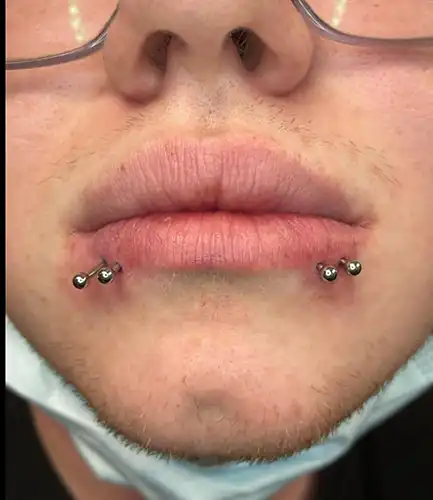
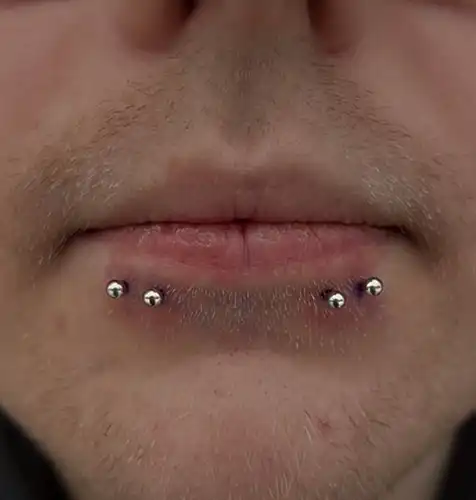
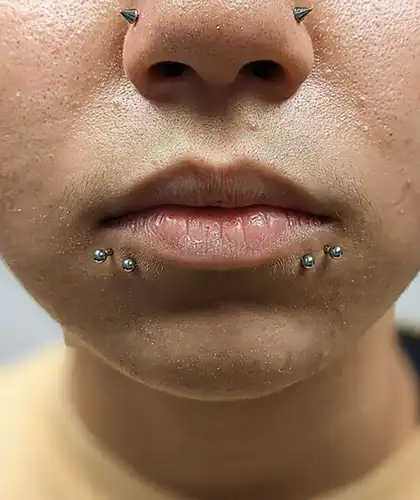


Possible side effects of Shark Bites Piercing
Getting a Shark Bites piercing involves multiple piercings on your lower lip, so it’s important to be aware of potential side effects and complications. Here are some possible side effects you might encounter:
- Swelling and Bruising
– Swelling: Swelling is common in the first few days after getting the piercing, especially since four piercings are done simultaneously. The swelling usually subsides within a week but can be managed with cold compresses or ice.
– Bruising: Some people may experience bruising around the pierced area, which should fade within a few days. - Pain and Discomfort: You may experience pain, tenderness, or discomfort during the healing process, especially when eating or speaking. This is normal and typically lessens as the piercings heal.
- Infection
– Signs: Redness, swelling, warmth, pain, or discharge (pus) from the piercing site are signs of an infection.
– Prevention: Proper aftercare, such as regular cleaning with saline solution and avoiding touching the piercings, can help prevent infections. - Gum and Tooth Damage
– Gum Recession: Constant contact between the jewelry and your gums can cause gum recession over time, which may lead to sensitivity or other dental issues.
– Tooth Erosion: The jewelry might rub against your teeth, causing enamel wear or chipping. - Scarring and Keloids
– Hypertrophic Scarring: Some people may develop raised scars around the piercing site, especially if the area is irritated or injured.
– Keloids: Keloids (thick, raised scars) can develop, although they’re more common in individuals prone to them. These are often harder to treat and may require medical intervention. - Piercing Migration or Rejection
– Migration: The body may push the jewelry toward the surface of the skin, causing the piercing to shift from its original position.
– Rejection: In some cases, the body may reject the piercing entirely, resulting in the jewelry being pushed out completely. - Allergic Reactions: An allergic reaction can occur if the jewelry contains nickel or other metals you’re sensitive to. Symptoms include redness, itching, swelling, or a rash around the piercing.
- Excessive Salivation or Dry Mouth: The piercings can cause temporary changes in saliva production, leading to excessive salivation or dry mouth. This usually resolves as you get used to the jewelry.
- Difficulty Eating or Speaking: You might experience challenges eating or speaking, especially in the first few days when the piercings are swollen and tender. This side effect should lessen as the piercings heal.
- Bacterial Infections or Oral Health Issues: Food particles can get trapped around the jewelry, leading to bacterial growth or plaque build-up. Proper oral hygiene, such as rinsing your mouth after eating, can help prevent this.
Tips to Minimize Side Effects
- Choose Quality Jewelry: Opt for high-quality, hypoallergenic materials like titanium, niobium, or gold to reduce the risk of allergic reactions and irritation.
- Follow Aftercare Instructions: Clean the piercings regularly with saline solution and avoid touching them with dirty hands.
- Monitor for Complications: Keep an eye out for unusual symptoms such as excessive redness, pain, or discharge, and consult your piercer or a healthcare professional if you suspect a problem.
By being aware of these possible side effects and taking preventive measures, you can minimize risks and ensure a smoother healing process for your Shark Bites piercings.
Get In Touch
For more information on the list above and any other special services,please call or come in for free consultation
Testimonials
After he pierced my industrial piercing and seeing his amazing work, I feel even more excited about getting my tattoo with him in January. I’m really looking forward to it!
I am extremely happy with my new 'Safari' tattoo from Eric at Rebel Inks! The quality of the artwork is fantastic. Eric is a true professional and an amazing artist.
The preparation and design process was thorough and collaborative. He was very patient with my specific requests, including making sure all the elements, which hold personal meaning, were perfect.
The service was friendly and highly professional from start to finish. Despite the 8-hour session, Eric was a pleasant person to spend the time with.
The aftercare guidance and follow-up have been excellent and careful, which has made the healing process easy and better than expected.
I highly recommend Eric for anyone looking for a thoughtful, talented, and caring tattoo artist.
I recommend them 💯
I would definitely recommend if you’re thinking of getting a piercing!
The staff were super friendly, explained everything clearly, and made me feel so at ease. They answered all my nervous questions (and I had many questions),
They walked me through the whole process, gave detailed aftercare instructions, and even followed up afterward to check how I was healing 🫶
Clean, professional, and full of good vibes.
Would 100% recommend . Definitely making a second trip here.
This was the second tattoo I got and I wish I could have come to Eric for my first one! He gave me really great after-care directions for the tattoo as well as a little jar of his own Vaseline-type stuff to put over my tattoo while it was healing! He even put second skin over my tattoo so that I didn’t have to worry about it for the first few days. Now THAT’S good service. My first tattoo artist didn’t do none of that lol.
After the session Eric didn’t rush me and my friend out, he chatted with us and even when he found out I was an artist too— really encouraged me to keep creating and to find a community of artists to support me. I almost cried because I’ve had such a hard time with my own art the past couple of years, it meant so much to me to have a fellow very talented artist say that to me. 🤍🤍🤍
Eric you’re amazing, don’t ever stop creating and just know you’ve impacted lives all over the world!🫶🏻 thanks so much for everything!!
From the moment I walked in, Eric was professional, welcoming, and attentive. He made sure I was comfortable throughout, provided everything I needed, and explained every step of the process. The tattooing itself was unbelievably smooth - I genuinely felt no pain compared to my previous tattoos over the last 22 years.
Eric also gave me excellent aftercare guidance and products, and thanks to that, my tattoo healed beautifully. The attention to detail, precision, and shading are absolutely stunning. This is hands-down the best tattoo I've ever had, and I will be flying back to Nairobi for any future ink.
If you want incredible art, a professional experience, and a talented artist who truly cares about his clients, Rebel Ink is the place to go!
From start to finish, the service was exceptional. The piercer was professional, knowledgeable, and made me feel completely comfortable. The cleanliness of the place was above and beyond — everything was spotless and hygienic, which really put me at ease. Highly recommend for anyone considering a piercing!
Shout out to Eric😘
We ended up changing the jewelry three times to ensure I had the best fit and avoided any signs of rejection, and he always listened to my suggestions as a client, which I really appreciated. Now, three months in, my piercing is healing beautifully, with no sign of rejection. Highly recommend for anyone who values a piercer who cares about your comfort and healing journey!
What stood out the most was the aftercare Eric checked in with me even three weeks later to see how the tattoo was healing. That kind of follow-up shows how much he truly cares about his work and his clients.
I’m very satisfied and will definitely be coming back for my next piece. Highly recommend!
The piercing wasn't as painful as I had thought and the process was quick and satisfactory. I love it!!!
The piercing is healing well thanks to the aftercare instructions and follow-up. I would highly recommend Rebel Inks
Eric also did a belly button piercing for a friend, guiding her through the process, doing the piercing and then explaining the after care to her.
The shop is on the 3rd floor, with the entrance to the stairs near an alleyway on the left. The shop is perfect size, clean, and attractive looking. The mural is pretty dope.
Thank you for the amazing service! 🔥👅✨
I got piercibgs there and the process was really good. My biggest concern was hygiene but that wasn't an issue at all, they use new needles and they sanitize them.
The service itself was also welcoming.
I was informes of everything i needed to know beforehand.
10/10 would recommend!
Eric was so calm and patient with my almost 2 year old lady. It was such a clean and hygienic process. We will definitely be back for our second rounds of piercings and maybe even another tattoo!
They assess the area before any art and advise one accordingly. They also give one post clean up process and also do a check up after the body art projects. Overall, I loved my experience and I’m hooked. 👍
Will definitely come back next time I’m in town 🙂
He listened to what I actually wanted and made sure he could fit in the time before I flew back home.
The shop is clean & private and is easy enough to find.
Eric has even checked in a couple of times since to make sure all is good.
I would totally recommend Eric! I absolutely love my Elephants!
I had a very easy healing period and always follow up from Eric to check on my progress...I would highly recommend if you are a first timer because from my experience all went very well and attention to detail
Thank you for a good job and looking forward to send all my friends your way
And all the best with the new year 2025!
From the moment I walked in, the staff was super friendly and made me feel at ease. The studio had a clean, professional atmosphere, which immediately put me at ease. My piercer was incredibly skilled and explained every step of the process, ensuring I was comfortable the entire time. The piercing was quick and practically painless, and the aftercare instructions were clear and easy to follow. I can tell they really care about the health and safety of their clients.
Overall, a fantastic experience—I highly recommend Rebel Inks and Tattoos for anyone looking to get pierced or tattooed!
They do follow up after their services
Eric's Studio isn’t just a place to get a tattoo—it’s an experience. The combination of professionalism, artistic talent, and a welcoming environment makes it a standout destination for anyone considering a tattoo.
I highly recommend Eric’s Studio to both first-timers and seasoned tattoo enthusiasts. If you’re looking for a high-quality tattoo and an enjoyable experience, this is the place to go.
I would definitely recommend their services again and again
Thank you Rebel Ink
My piercings are healing ❤️🩹 well
I would 💯 recommend
I will definitely come back for more .
Two, all the equipments he used for the piercings were new and/or sterilised.
Three, the parlour itself was very clean and was up to par with the hygiene standards.
Four, Eric provided effective aftercare instructions, making sure I knew exactly how to take care of my new piercings and he kept in touch and continues to do so, to check on the healing progress.
I highly highly highly recommend this place!!!
Would definitely recommend them to friends and go back for other piercings
Not only was the piercing process smooth, but he also provided thorough aftercare instructions, making sure I knew exactly how to take care of my new piercings. What really impressed me was that he keeps in touch to check on how the healing is progressing – a sign of true care for his clients.
The shop maintains a high standard of hygiene, and the atmosphere is welcoming and comfortable, which really added to the positive experience. I highly recommend this place to anyone looking for a professional and caring experience. I’ll definitely be coming back for any future piercings!
My appreciation for the excellent customer service I received. The follow-ups were prompt, and I truly appreciated the gentleness and professionalism throughout. Thank you!"
"Looking for professional eyebrow microshading removal? Look no further!"
The customer care is top tier 👌🏾👌🏾.
Wonderful place to get tattoos and piercings. 💯💯
Eric goes ahead to follow up on his clients progress and gives good advice each time I reach out to him.
I would recommend Reble tattoos anytime.
Good job bro we really appreciate.
Ohh and the price is very fair.
The environment was clean , procedure was sterile and the jewelry used are of the best quality.
He followed up with me during the healing process, he educated me on what I needed to do for my aftercare.
Eric is confident, skilled , experienced and the best piercer. Highly recommend Rebel inks.✨
Definitely recommend!
Great experience.
Eric definitely know what he is doing .
I got exactly what I wanted 2 tiny tats on the same finger .
He was kind and patient throughout the session.
Healing process has been good .
Aftercare services were given and regular checkups on the healing process were done.
I would 💯recommend.
Eric gave me the best reception as it was my first time there,and made me trust him all the way. I appreciate good services.
There services are also affordable not to forget 😊.
He was also invested in the aftercare and would ensure I follow the do's and don'ts in taking care of the tattoo and ensuring proper healing and maximum ink retention.
Would highly recommend Rebel Inks Tattoos.
Rebel Inks Tattoo offer the best,affordable and quality tattoo removal services.If you have unwanted ink,choose Rebel Inks Tattoo,they're the best of the best and the professionalism is a top notch.They ensure you're free from unwanted ink with their Laser Tattoo Removal Technology...
I did a Laser Tattoo Removal with them and i can attest they're the best....
Kudos Eric...
I highly recommend.
It was a generally good experience with good hygiene during the piercing process and has been a smooth healing process.... 10/10
tips. Highly recommend 👍🏽
100% recommendable.
I was particularly impressed with Eric's attention to hygiene. He thoroughly cleaned the room before I entered, sanitized all of the equipment he would be using, and changed gloves between each ear. This level of cleanliness gave me great confidence in his professionalism.
Eric's commitment to customer service did not end on the day of the piercing. He followed up with me regularly throughout the healing process to ensure that I was following the aftercare instructions and that my earlobes were healing properly.
I highly recommend Rebel Inks to anyone in Nairobi who is considering getting a piercing. Eric is a highly skilled and experienced piercer who takes great pride in his work.
So I Check all the boxes below and more:
Customer Care: ✔️
Professionalism : ✔️
Cleanliness ✔️
Price: ✔️
After care service ✔️
Thanks and good job, Eric
The place is neat and clean and the equipments he used were also fine standards. Really appreciate his following up with me on the healing 🤗
I WOULD HIGHLY RECOMMEND THEIR SERVICES to everyone. Actually what you see on their website is EXACTLY what you will get. Keep up the good work Rebel inks Tattoos.
The infection is now gone. I would definitely recommend!
Can recommend this place totally and would go back there anytime!
Thanks!
OUR LOCATION
Areas We Serve
NAIROBI
KIAMBU
KAJIADO
MACHAKOS



